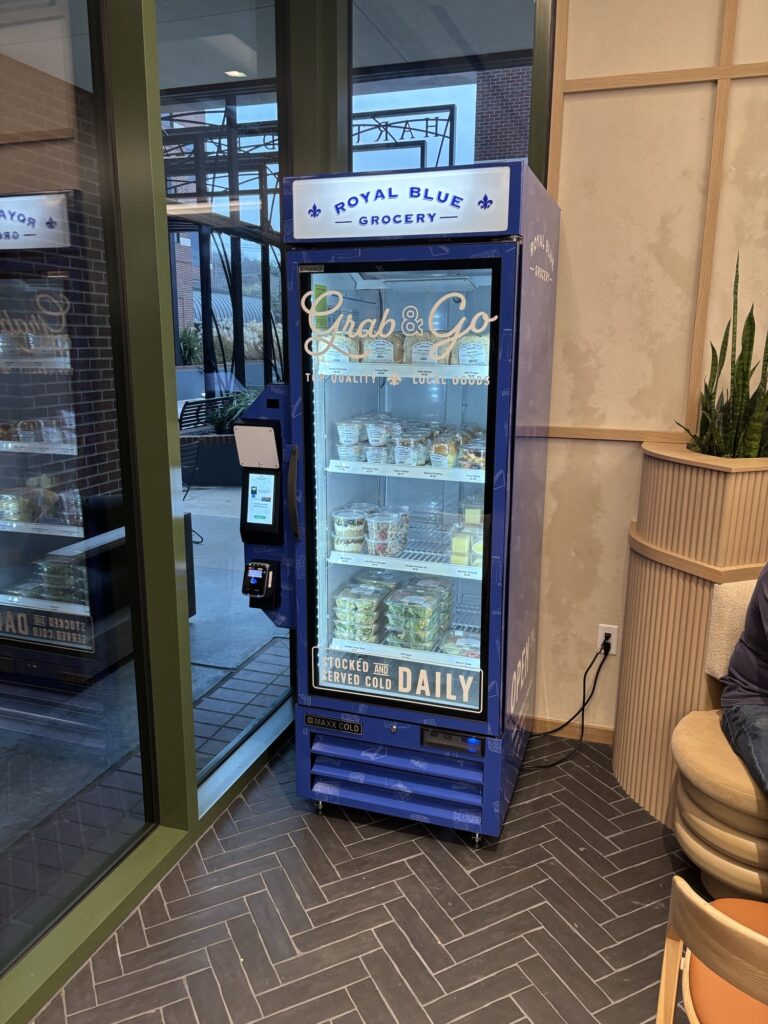The Campus Food Challenge
 College and university students face a unique set of nutritional challenges. Between irregular class schedules, late-night study sessions, limited budgets, and the demands of academic life, maintaining healthy eating habits often falls by the wayside. While campus dining halls provide meal services during standard hours, students frequently find themselves needing food access outside those windows—early mornings before 7am classes, late nights in the library, weekends when dining options are limited, or between classes when there's no time for a full sit-down meal.
College and university students face a unique set of nutritional challenges. Between irregular class schedules, late-night study sessions, limited budgets, and the demands of academic life, maintaining healthy eating habits often falls by the wayside. While campus dining halls provide meal services during standard hours, students frequently find themselves needing food access outside those windows—early mornings before 7am classes, late nights in the library, weekends when dining options are limited, or between classes when there's no time for a full sit-down meal.
Traditional campus food solutions leave significant gaps:
- Dining halls operate on fixed schedules that don't accommodate all students
- Campus convenience stores often emphasize packaged snacks over fresh, nutritious meals
- Off-campus options are expensive, time-consuming to access, and often unhealthy
- Traditional vending machines offer limited selections focused on chips, candy, and soda
Universities are increasingly recognizing that student success depends on more than just academic support—physical health, including proper nutrition, plays a critical role in cognitive function, stress management, and overall well-being. Students who have convenient access to healthy, affordable food options perform better academically, report higher satisfaction with their university experience, and demonstrate better health outcomes.
Fresh food vending solutions, particularly RFID-enabled smart vending systems like REDYREF's Fresh Food Fridge, address these challenges by providing 24/7 access to nutritious meals throughout campus in a format that's convenient, affordable, and scalable.
Why Universities Are Turning to Fresh Food Vending
Modern fresh food vending machines solve multiple challenges universities face in supporting student nutrition:
24/7 Access Aligned with Student Schedules
College students don't operate on 9-to-5 schedules. Classes, labs, study groups, and academic deadlines create irregular patterns that traditional dining services struggle to accommodate.
Early Morning Access: Students with 8am classes often skip breakfast because dining halls don't open early enough. Fresh food vending provides grab-and-go breakfast options—yogurt parfaits, breakfast sandwiches, fruit cups, protein bars—available whenever students need them.
Late-Night Study Fuel: During finals week or when working on major projects, students often study late into the night. Having access to nutritious meals and snacks in libraries, study lounges, and academic buildings supports their academic efforts without forcing them to choose between studying and eating.
Weekend Coverage: Many campus dining facilities operate on reduced schedules or close entirely on weekends, leaving students—particularly those who live on campus—with limited options. Fresh food vending operates continuously, ensuring students always have access to meals.
Between-Class Convenience: Students with back-to-back classes or short breaks between lectures need quick food access. Fresh food vending's "tap, take, go" transaction process takes seconds, allowing students to grab a meal and make it to their next class on time.
Supporting Student Health & Wellness Initiatives
 Universities increasingly prioritize student wellness as integral to academic success and retention. Fresh food vending aligns with these initiatives by providing:
Universities increasingly prioritize student wellness as integral to academic success and retention. Fresh food vending aligns with these initiatives by providing:
Nutritious Options: Modern fresh food vending offers balanced meals with:
- Fresh salads with lean proteins
- Whole grain sandwiches and wraps
- Fresh fruit and vegetable options
- Greek yogurt and high-protein snacks
- Meals meeting dietary requirements (vegetarian, vegan, gluten-free)
Transparent Nutritional Information: Touchscreen interfaces display complete nutritional data—calories, protein, carbohydrates, fats, allergens—helping students make informed choices aligned with their health goals.
Healthier Than Alternatives: Compared to late-night pizza delivery, fast food, or vending machine snacks, fresh food vending provides superior nutritional value at competitive prices.
Mental Health Connection: Research consistently shows that nutrition impacts mental health, stress levels, and cognitive function. Universities supporting student mental health recognize that convenient access to healthy food is part of comprehensive wellness support.
Budget-Friendly for Universities & Students
University administrators face constant pressure to deliver value while managing tight budgets. Fresh food vending provides cost-effective solutions for both institutions and students.
For Universities:
Lower Infrastructure Investment: Fresh food vending requires minimal upfront investment compared to building or expanding dining facilities:
- No construction or renovation costs
- No kitchen equipment or facilities needed
- No additional dining hall staff required
- Minimal space footprint (10-45 sq ft depending on configuration)
A single RFID vending unit costs $7,500, while a three-unit micro market configuration costs $22,500—a fraction of the cost of expanding traditional dining infrastructure. Monthly technology support fees ($199/month per unit), transaction fees ($0.25 + merchant fees), and RFID tags ($0.18 each) are typically covered through product pricing.
Flexible Financial Models: Universities can work with service providers who place equipment at no upfront cost, recovering their investment through product sales. This eliminates capital expenditure requirements while still providing enhanced student services.
Reduced Operating Costs: Automated operation means no additional staffing costs, no utility expenses for operating kitchens, and no facility maintenance beyond what service providers handle.
For Students:
Competitive Pricing: Fresh food vending typically offers meals in the $4-$8 range—comparable to or less expensive than dining hall meals and significantly cheaper than off-campus restaurants or delivery services.
Meal Plan Integration: Universities can integrate fresh food vending with existing meal plan systems, allowing students to use their meal cards or declining balance accounts for purchases. This provides flexibility without requiring students to carry additional payment methods.
Reduced Food Waste: Students only purchase what they'll actually consume, reducing the waste (and cost) associated with dining hall meal plans that force students to take full meals even when they only want a snack or light meal.
Campus-Wide Placement Flexibility
 Unlike centralized dining halls, fresh food vending's compact footprint enables strategic placement throughout campus wherever students congregate:
Unlike centralized dining halls, fresh food vending's compact footprint enables strategic placement throughout campus wherever students congregate:
Residence Halls: Placing units in dormitory common areas provides immediate access for students living on campus, particularly valuable for late-night and early-morning needs.
Libraries & Study Spaces: Students spending long hours studying need convenient food access without leaving the library. Fresh food vending supports extended study sessions without forcing students to choose between productivity and nutrition.
Academic Buildings: Science labs, engineering facilities, and other specialized academic spaces often require students to remain in or near the building for extended periods. On-site fresh food vending eliminates the need to leave campus facilities.
Recreation & Athletic Centers: Students and athletes using campus recreation facilities benefit from healthy, protein-rich options supporting active lifestyles and recovery.
Student Centers & Commons: High-traffic gathering spaces are natural locations for fresh food vending, serving the broadest student population and creating social spaces around food access.
Graduate & Professional School Buildings: Graduate students often have different schedules and needs than undergraduates. Dedicated fresh food vending in graduate facilities acknowledges their unique requirements.
Scalable Implementation
Universities can implement fresh food vending incrementally, starting with high-priority locations and expanding based on demand and budget:
Phase 1 - Pilot Program: Begin with 1-2 units in the highest-traffic location (typically the main library or student center). Monitor usage, gather student feedback, and demonstrate ROI before broader rollout.
Phase 2 - Strategic Expansion: Add units to 3-5 additional locations based on pilot program success: residence halls, academic buildings, recreation centers.
Phase 3 - Campus-Wide Network: Expand to comprehensive coverage with 10-15+ units distributed throughout campus, creating a true fresh food access network.
This modular approach allows universities to:
- Test market demand before major investment
- Adjust product offerings based on actual student preferences
- Expand at a pace aligned with budget cycles
- Demonstrate value to stakeholders through pilot data
Key Features for Campus Environments
Fresh food vending solutions designed for university environments should include specific features supporting student needs:
Meal Plan & Payment Integration
University ID Card Acceptance: Smart vending machines can integrate with campus card systems, allowing students to use their existing university ID cards for purchases.
Meal Plan Balance Deduction: Students with meal plans or declining balance accounts can use those funds for vending purchases, providing flexibility in how they use their allocated dining dollars.
Multiple Payment Methods: Beyond meal plans, vending should accept:
- Credit and debit cards
- Mobile payments (Apple Pay, Google Pay)
- Contactless payments
- Cash (where applicable)
Guest Access: Parents, visitors, and campus guests should be able to make purchases using standard payment methods even if they don't have campus ID cards.
Product Selection for Student Demographics
 Universities serve diverse student populations with varying dietary needs, preferences, and budgets. Fresh food vending menus should reflect this diversity:
Universities serve diverse student populations with varying dietary needs, preferences, and budgets. Fresh food vending menus should reflect this diversity:
Breakfast Options:
- Yogurt parfaits with granola
- Breakfast sandwiches and wraps
- Fresh fruit cups
- Overnight oats
- Protein bars and shakes
Lunch & Dinner:
- Fresh salads with protein options
- Sandwiches and wraps
- Grain bowls
- Pasta dishes
- Sushi and poke bowls
Snacks & Lighter Options:
- Fresh fruit and vegetables with dip
- Hummus and veggie packs
- Cheese and crackers
- Mixed nuts and trail mix
- Greek yogurt
Dietary Accommodations:
- Vegetarian and vegan options
- Gluten-free selections
- Allergen-friendly items clearly labeled
- Halal certified options where needed
- Low-carb and high-protein choices
Beverages:
- Water and sparkling water
- 100% fruit juices
- Protein shakes
- Coffee drinks
- Tea options
Student-Friendly Interface Design
University students are digital natives comfortable with technology. Fresh food vending interfaces should leverage this:
Intuitive Touchscreens: Large, responsive touchscreens with clear navigation make selection quick and easy, even for first-time users.
Nutritional Transparency: Display complete nutritional information including:
- Calories and macronutrients
- Ingredient lists
- Allergen warnings
- Dietary category tags (vegan, gluten-free, etc.)
Quick Transaction Process: "Tap, take, go" functionality with RFID technology means students spend seconds, not minutes, completing purchases.
Multi-Language Support: International student populations benefit from interface options in multiple languages.
Remote Management & Real-Time Data
University dining services administrators need visibility into vending operations across campus:
Centralized Dashboard: Monitor all campus vending units from a single interface showing:
- Real-time inventory levels at each location
- Sales data by unit, product, and time period
- Machine health status and alerts
- Usage patterns across campus
Automatic Restocking Alerts: RFID technology tracks inventory precisely, sending alerts when popular items need replenishment or when products approach expiration dates.
Data-Driven Decision Making: Sales analytics reveal which products are popular at which locations, allowing data-driven menu optimization. A unit in the recreation center might stock more protein-heavy options while a library unit emphasizes lighter snacks and brain foods.
Performance Metrics: Track key metrics supporting program evaluation:
- Total transactions and revenue by location
- Peak usage times and patterns
- Student satisfaction (through feedback mechanisms)
- Comparison to traditional dining service utilization
Implementation Considerations for Universities
Successfully implementing fresh food vending on campus requires attention to several key factors:
Location Selection Strategy
 High-Traffic Areas: Prioritize locations with consistent foot traffic throughout the day and week. Student centers, sports facilities and major residence halls can offer the high utilization patterns.
High-Traffic Areas: Prioritize locations with consistent foot traffic throughout the day and week. Student centers, sports facilities and major residence halls can offer the high utilization patterns.
Underserved Populations: Identify student populations currently lacking convenient food access:
- Graduate students in specialized facilities
- Students with evening or weekend class schedules
- Athletes with early morning or late practice schedules
- Commuter students between classes
Physical Requirements: Each unit needs:
- Electrical access (standard 110V outlet)
- Network connectivity (WiFi or cellular)
- 10-15 square feet of floor space
- Climate-controlled environment
Security Considerations: While RFID vending machines are designed with security features, placement in monitored or high-visibility areas reduces vandalism risk.
Student Engagement & Communication
Pre-Launch Promotion: Build awareness and excitement before vending units go live:
- Social media campaigns highlighting new convenience
- Campus newspaper or blog features
- Student government announcements
- Signage in target locations
Grand Opening Events: Consider launch promotions or events:
- Discounted items during first week
- Free samples of popular products
- Student feedback sessions
- Social media contests
Ongoing Communication: Keep students informed about:
- New product additions based on feedback
- Seasonal menu changes
- Special promotions or deals
- How to provide feedback or request products
Feedback Mechanisms: Create easy ways for students to share input:
- QR codes on machines linking to feedback forms
- Email address for suggestions
- Integration with existing student feedback platforms
- Regular surveys about satisfaction and product preferences
Partnership with Dining Services
Fresh food vending should complement, not compete with, existing dining services:
Integrated Strategy: Position vending as part of comprehensive dining services strategy:
- Dining halls for full-service meals during peak hours
- Retail dining for variety and specialization
- Fresh food vending for 24/7 convenience and quick access
Meal Plan Inclusion: Work with dining services to include vending in meal plan options and communications, ensuring students understand how to use meal plans or dining dollars at vending locations.
Nutritional Consistency: Coordinate with campus dietitians or nutritionists to ensure vending offerings align with university wellness standards and dietary guidelines.
Cross-Promotion: Dining services can promote vending as an extension of their services rather than a separate or competing option.
Service Provider Selection
Universities should evaluate fresh food vending providers based on:
Product Quality & Variety: Assess the provider's food sourcing, quality standards, and ability to accommodate diverse menu requirements.
Technology Platform: Evaluate the sophistication of inventory management, reporting capabilities, and remote monitoring systems.
Service Reliability: Consistent restocking schedules, rapid response to issues, and proactive maintenance are critical for student satisfaction.
Financial Flexibility: Understand available financial models—equipment purchase, leasing, or service provider placement—and choose the option aligned with university budget processes.
Sustainability Practices: Many universities prioritize environmental sustainability. Evaluate providers' commitment to:
- Waste reduction through RFID inventory management
- Sustainable packaging materials
- Energy-efficient equipment
- Local food sourcing where possible
Typical University Applications
Common application scenarios demonstrate how fresh food vending serves different campus environments:
Large Public University Scenario (25,000+ students)
Typical Challenge: Five-story library open 24/7 during academic year, but food options closed by 9pm. Students studying late night have no convenient access to meals or snacks.
Potential Solution: Two RFID fresh food vending units on library main floor—one refrigerated unit for meals, one ambient cabinet for snacks and beverages.
Expected Benefits:
- High transaction volume during late-night hours when other dining is closed
- Peak usage during evening study periods (9pm-2am)
- Improved student satisfaction with late-night food access
- Reduced complaints about lack of study-friendly food options
- Success could justify expansion to additional library locations
Private Liberal Arts College Scenario (3,500 students)
Typical Challenge: Single dining hall can't accommodate all student schedules, particularly athletes with early training, science students with evening labs, and students with dietary restrictions.
Potential Solution: Six-unit campus-wide network:
- Two units in main residence hall complexes
- One unit in athletics facility
- One unit in science building
- Two units in student center
Expected Benefits:
- Consistent transaction volume across all locations
- Reduced dining hall congestion during peak meal times
- Improved student satisfaction with dining flexibility
- Meal plan integration providing payment convenience
- Demonstrated value could justify further campus expansion
Community College Scenario (8,000 students)
Typical Challenge: Primarily commuter student population with classes scheduled throughout day and evening. Many students eating fast food between classes due to limited on-campus options.
Potential Solution: Three RFID vending units in main student commons area, creating a micro market experience with variety of fresh food, beverages, and snacks.
Expected Benefits:
- Convenient food access for commuter students between classes
- Healthier eating options compared to off-campus fast food
- Reduced time students spend leaving campus for meals
- Competitive pricing ($4-7 per meal) making healthy eating accessible
- Revenue generation that could support other student services
The REDYREF Advantage for Universities
REDYREF brings over 100 years of kiosk manufacturing experience to university fresh food vending solutions, offering advantages specifically valuable in campus environments:
Proven Campus Experience
REDYREF's client portfolio includes numerous educational institutions, demonstrating proven ability to serve university needs. This experience translates to:
- Understanding of academic calendar cycles
- Knowledge of student usage patterns
- Experience with university procurement processes
- Established relationships with campus dining service providers
Customization Capabilities
In-house manufacturing enables customization supporting university requirements:
- Custom exterior branding with university colors and logos
- Integration with specific campus card payment systems
- Modified configurations fitting unique campus spaces
- Custom reporting aligned with university needs
Scalable Solutions
Universities can implement REDYREF solutions at whatever scale matches current needs and budget:
- Start small: Single unit pilot program ($7,500 equipment + $199/month support)
- Strategic expansion: 5-10 units across key locations ($37,500-$75,000 equipment + ongoing fees)
- Campus-wide network: 15-20+ units comprehensive coverage ($112,500-$150,000 equipment + ongoing fees)
Modular approach means universities never over-commit to infrastructure exceeding actual demand.
Manufacturing Quality & Reliability
ISO 9001:2015 Certification: REDYREF's certified manufacturing processes ensure consistent quality and reliability—critical when students depend on vending access daily.
Durable Construction: Campus environments demand equipment built to withstand heavy use. REDYREF units feature:
- High-grade steel construction
- Powder-coated finishes resistant to wear
- Commercial-grade refrigeration systems
- Vandal-resistant design elements
Long-Term Support: With over 100 years in business, REDYREF provides assurance of long-term parts availability, service support, and technology updates.
Partnership Approach
REDYREF works collaboratively with universities and campus dining services to create optimal solutions:
- Consultation on location strategy
- Product mix recommendations based on student demographics
- Integration planning with existing systems
- Training for university staff
- Ongoing optimization based on performance data
Supporting Student Success Through Nutrition
Universities have a responsibility to support student success holistically—and that includes ensuring students have convenient access to nutritious food that fuels their academic endeavors, supports their health and wellbeing, and fits their irregular schedules and limited budgets.
Fresh food vending, particularly modern RFID-enabled solutions, provides universities with a cost-effective, scalable, and student-friendly approach to addressing campus nutrition needs. By placing smart fresh food vending machines strategically throughout campus, universities demonstrate commitment to student welfare while creating infrastructure that operates 24/7 without significant ongoing costs.
Whether your school needs a single pilot unit in your student center, or a comprehensive campus-wide network serving thousands of students, REDYREF's experience, manufacturing quality, and flexible approach can support your goals.
Ready to explore how fresh food vending can enhance your campus dining services and student experience? Contact REDYREF today to discuss your specific campus needs, student demographics, and implementation goals. Our team brings over 100 years of kiosk manufacturing experience and proven success serving educational institutions.
Let's work together to ensure your students have the nutrition they need to succeed academically, maintain their health, and enjoy their university experience.

 College and university students face a unique set of nutritional challenges. Between irregular class schedules, late-night study sessions, limited budgets, and the demands of academic life, maintaining healthy eating habits often falls by the wayside. While campus dining halls provide meal services during standard hours, students frequently find themselves needing food access outside those windows—early mornings before 7am classes, late nights in the library, weekends when dining options are limited, or between classes when there's no time for a full sit-down meal.
College and university students face a unique set of nutritional challenges. Between irregular class schedules, late-night study sessions, limited budgets, and the demands of academic life, maintaining healthy eating habits often falls by the wayside. While campus dining halls provide meal services during standard hours, students frequently find themselves needing food access outside those windows—early mornings before 7am classes, late nights in the library, weekends when dining options are limited, or between classes when there's no time for a full sit-down meal. Universities increasingly prioritize student wellness as integral to academic success and retention. Fresh food vending aligns with these initiatives by providing:
Universities increasingly prioritize student wellness as integral to academic success and retention. Fresh food vending aligns with these initiatives by providing: Unlike centralized dining halls, fresh food vending's compact footprint enables strategic placement throughout campus wherever students congregate:
Unlike centralized dining halls, fresh food vending's compact footprint enables strategic placement throughout campus wherever students congregate: Universities serve diverse student populations with varying dietary needs, preferences, and budgets. Fresh food vending menus should reflect this diversity:
Universities serve diverse student populations with varying dietary needs, preferences, and budgets. Fresh food vending menus should reflect this diversity: High-Traffic Areas: Prioritize locations with consistent foot traffic throughout the day and week. Student centers, sports facilities and major residence halls can offer the high utilization patterns.
High-Traffic Areas: Prioritize locations with consistent foot traffic throughout the day and week. Student centers, sports facilities and major residence halls can offer the high utilization patterns.